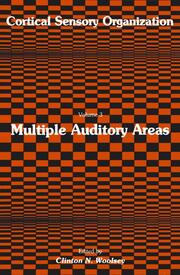Detailansicht
Cortical Sensory Organization
Multiple Auditory Areas, Cortical Sensory Organization 3
ISBN/EAN: 9781461258193
Umbreit-Nr.: 5657602
Sprache:
Englisch
Umfang: xvi, 266 S.
Format in cm:
Einband:
kartoniertes Buch
Erschienen am 12.10.2011
Auflage: 1/1982
- Zusatztext
- In April 1979 a symposium on "Multiple Somatic Sensory Motor, Visual and Auditory Areas and Their Connectivities" was held at the FASEB meeting in Dallas, Texas under the auspices of the Committee on the Nervous System of the American Physiological Society. The papers presented at that symposium are the basis of most of the substantially augmented, updated chapters in the three volumes of Cortical Sensory Organization. Only material in chap ter 8 of volume 3 was not presented at that meeting. The aim of the symposium was to review the present status of the field of cortical representation in the somatosensory, visual and auditory systems. Since the early 1940s, the number of recognized cortical areas related to each of these systems has been increasing until at present the number of visually related areas exceeds a dozen. Although the number is less for the somatic and auditory systems, these also are more numerous than they were earlier and are likely to increase still further since we may expect each system to have essentially the same number of areas related to it.
- Autorenportrait
- Inhaltsangabe1 The Auditory Cortex: Patterns of Corticocortical Projections Related to Physiological Maps in the Cat.- 1. Tonotopic Organization.- 1.1. Field A I.- 1.2. Field A.- 1.3. Fields P and VP.- 1.4. Isofrequency Contours.- 1.5. The Peripheral Auditory Belt.- 2. Corticocortical Conections Related to Best-Frequency Maps.- 2.1. Relationship between Best Frequencies Located at the Sources and Terminations of Corticortical Connections.- 2.2. Topography of Projections: Patches and Bands.- 3. Binaural Organization of A I.- 4. Corticocortical Connections Related to Binaural Maps.- 4.1. Patterns of Callosal Innervation in A I.- 4.2. Patterns of Ipsilateral Corticocortical Terminations in A I.- Abbreviations.- References.- 2 Auditory Forebrain Organization: Thalamocortical and Corticothalamic Connections in the Cat.- 1. Introduction.- 1.1. Redefinition of Auditory Cortical Fields in the Cat.- 1.2. Internal Organization of Auditory Cortical Fields.- 1.3. Internal Organization of the Medial Geniculate Body (MGB).- 2. Basic Approach.- 3. Summary of Results.- 3.1. Geometry of Arrays of Neurons Projecting from MGB to A I.- 3.2. Banding of the MGB Ventral Division Projection.- 3.3. Descending Corticothalamic Projections from A I to the MGB.- 3.4. Interconnections of MGB Nuclei with Other Cortical Fields.- 4. Conclusions.- Acknowledgments.- References.- 3 Auditory Cortical Areas in Primates.- 1. Early Studies in Monkeys, Apes and Humans.- 2. Microelectrode Studies of the Organization of Primate Auditory Cortex.- Acknowledgments.- References.- 4 Organization of Auditory Connections: The Primate Auditory Cortex.- 1. Introduction.- 2. Cytoarchitecture of the Medial Geniculate Body.- 3. Projections to the Medial Geniculate.- 4. Projections to Other Thalamic Nuclei.- 5. Projections to the Inferior Colliculus.- 6. Cortical Projections.- 7. Ipsilateral Cortical Projections.- 8. Contralateral Cortical Projections.- Abbreviations.- References.- 5 Polysensory "Association" Areas of the Cerebral Cortex: Organization of Acoustic Input in the Cat.- 1. Introduction.- 1.1. Cortical Association Areas and Hypothesized Sources of Sensory Input.- 1.2. Lesion Studies of Acoustic Input and the Question of Specific Receptive-Field Properties.- 2. Methods.- 3. Acoustic Properties of Neurons in Cortical Association Fields.- 3.1. General Response Properties.- 3.2. Frequency Tuning and Thresholds.- 3.3. Binaural Properties.- 4. The Nonspecific Projection System.- 4.1. Acoustic Input to Medial/Intralaminar Thalamus.- 4.2. Cortical Projections from Medial/Intralaminar Thalamus.- 4.3. The Mesencephalic Reticular Formation: Acoustic Input and Connections.- 4.4. Conclusions and Commentary.- 5. The Auditory "Lemniscal Adjunct" System.- 5.1. The "Lemniscal Line"/"Lemniscal Adjunct" Distinction.- 5.2. The Pulvinar-Posterior Complex: Acoustic Input and Connections.- 5.3. Possible Input from Auditory Cortex.- 6. Chloralose Anesthesia and the Functional Interpretation of the Data.- 7. Conclusions and Final Considerations.- Acknowledgments.- References.- 6 Functional Organization of the Auditory Cortex: Representation Beyond Tonotopy in the Bat.- 1. Introduction.- 1.1. Hypotheses and Neurophysiology of Cortical Representation of Auditory Information.- 1.2. Unique Aspects of the Biosonar Signals and the Peripheral Auditory System of the Mustached Bat.- 2. Methods.- 2.1. Materials.- 2.2. Surgery.- 2.3. Animals During Experiments.- 2.4. Acoustic Stimuli.- 2.5. Data Acquisition.- 2.6. Anesthetics and Neural Activity.- 3. Results and Discussion.- 3.1. Areas Specialized for Processing Biosonar Information in the Cerebrum.- 3.2. Extraction of Information-Bearing Elements and Examination of Their Combinations.- 3.3. Specialized and Unspecialized Neurons.- 3.4. Parallel-Hierachical Processing.- 3.5. Specialized Neurons as IBP Filters.- 3.6. Appendix.- 4. Summary and Conclusions.- Acknowledgments.- References.- 7 A Theory of Neural Auditory Space: Auditory Representation in the Owl and Its Sign
